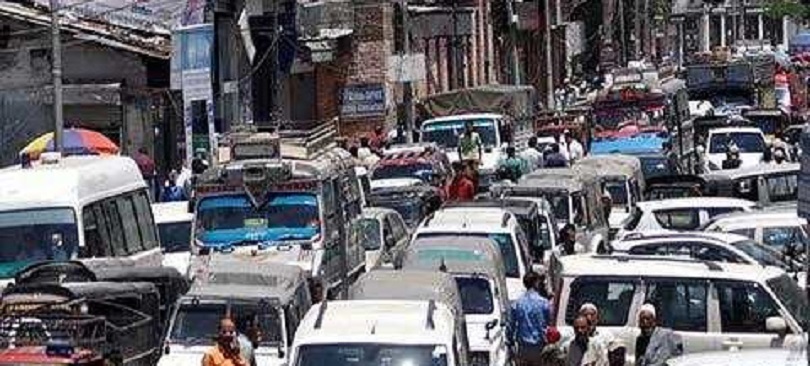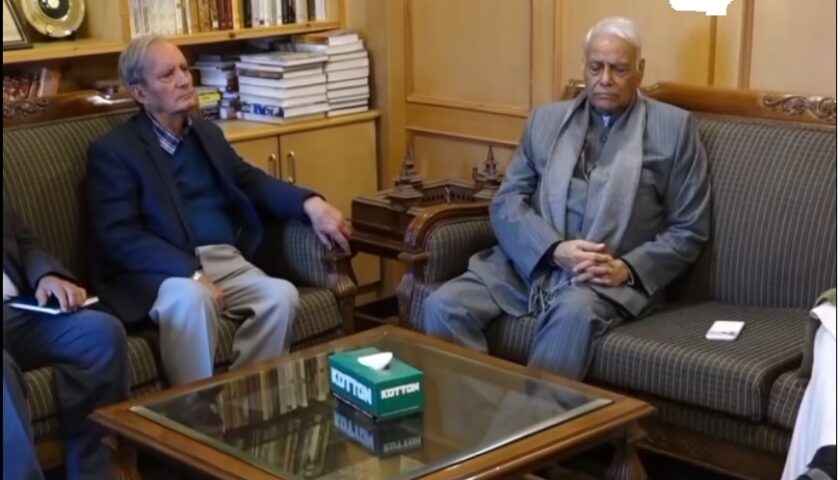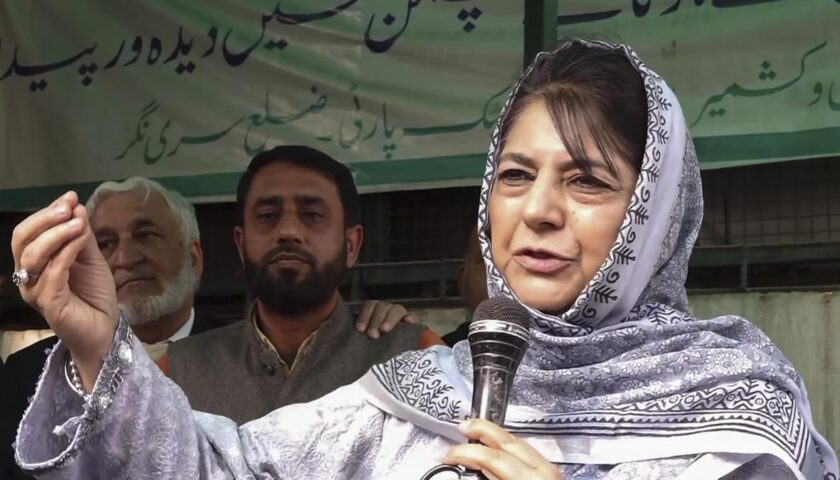Choked Streets, Silent Lights — Why Srinagar’s Traffic Jams Are Getting Worse (Analysis & Solutions)
By: Javid Amin | 02 November 2025
Every morning and evening, Srinagar — the summer capital that pours itself along the Jhelum — locks up. Commuters inch along tightly packed lanes, schoolchildren arrive late, shop owners lose customers, ambulances crawl at critical moments, and tempers fray. The causes are many: an explosion in vehicle numbers, narrow historic streets, repeated failures of signal infrastructure, chronic encroachments and intermittent manual traffic controls at major junctions.
This article lays out the facts, explains what recent technical interventions (like the Intelligent Traffic Management System) are meant to do, tallies the human cost, and offers pragmatic steps for the authorities. Key infrastructure and trend figures are verified below to anchor the analysis.
Snapshot: Five Key Facts
-
Srinagar Smart City launched an Intelligent Traffic Management System (ITMS) and an e-challan system in December 2024 to modernize traffic operations.
-
As part of the ITMS rollout, local reports state about 1,000 cameras were deployed at 62 out of 66 junctions, feeding an Integrated Command and Control Center.
-
Regional reporting and transport data indicate that vehicle registrations in Jammu & Kashmir roughly doubled over eight years, reaching more than 2.5 million vehicles by March 2024 — a surge that strains narrow urban roads.
-
Government statements to local media note that many traffic signals remain non-functional or are operated manually in Srinagar, causing inconsistent traffic control and confusion during peak hours. (Local traffic department briefings and reporting.)
-
The initial ITMS deployment was part of a broader smart-city effort proposed in prior years at approximate planning costs in the range of several crores (projected ITMS cost mentioned in planning documents and media summaries). Implementation steps included ICCC setup and phased activation across junctions.
The human picture: Commutes turned into ordeals
“Where thirty minutes used to be the rule, today it’s an hour — sometimes two,” says Burhan Ahmad, who crosses Srinagar daily from Downtown to the university area. He is not alone. Parents, office workers, shopkeepers and drivers describe repeated scenes of crawling traffic at school and office hours.
Common complaints collected from commuters and shopkeepers include:
-
Traffic lights being switched off or non-functional at key junctions, shifting control to hand-directed traffic marshals who can’t cope during high flow.
-
Narrow roads squeezed further by roadside parking and vendor encroachments, forcing vehicles into single lanes or onto sidewalks.
-
Short detours and ad-hoc diversions at major crossings (Zero Bridge, Rambagh, Budshah Chowk) that create cascading delays across neighborhoods.
-
The feeling — sometimes voiced strongly — that VIP movements or occasional management lapses make normal traffic flow worse for ordinary commuters.
These everyday disruptions have more than inconvenience: late arrivals for exams and office, missed appointments, lost business leads for shop owners, and crucially, delayed emergency services. Srinagar’s ambulance routes — particularly those to SKIMS Soura and other tertiary centres — pass through known chokepoints and are regularly impeded.
Anatomy of the gridlock: Why Srinagar’s roads choke
Urban congestion has many causes; in Srinagar a few structural features amplify the problem:
-
Historic urban form
Srinagar’s old city grew around waterways and narrow lanes long before motor vehicles. Roads like Maulana Azad Road and the Maulvi Bazar–Budshah Chowk stretch are constrained by buildings, vendors and legacy land-use patterns. These constrained cross-sections cannot absorb modern traffic volumes without deliberate redesign. -
Rapid motorization
Regional data show a steep rise in vehicle registrations across Jammu & Kashmir in recent years — more citizens own two-wheelers, cars and small commercial vehicles than before — and Srinagar absorbs a significant share of that growth, magnifying peak flows. Higher car ownership increases parking demand and kerbside use, squeezing available carriageway. -
Encroachments and roadside activity
Street vendors, informal showrooms of automobile dealers, and parked vehicles regularly occupy footpaths and road edges in areas like Nowhatta, Bahrambagh, Hari Singh High Street, Saira Balla, and Saida Kadal. This forces pedestrians into the carriageway and reduces the effective road width, creating localized bottlenecks. -
Mixed traffic and poor segregation
The city continues to mix private cars, taxis, two-wheelers, autorickshaws, cycle rickshaws and pedestrians on narrow streets. Without defined lanes or kerb discipline, minor slowdowns cascade into larger jams. -
Signal and control failures
Many traffic signals are reported to be non-functional, switched off, or manually overridden during certain periods. That inconsistent signaling creates driver confusion and under-utilization of intersection capacity. Local traffic managers sometimes opt to switch signals off believing manual control is more responsive — but in practice this can increase imbalance and reduce throughput. -
Lack of effective parking policy
On-street parking is widespread and often unmanaged, reducing lane capacity. Off-street parking facilities are limited or poorly distributed relative to demand.
The ITMS promise — and the reality on the ground
The Srinagar Smart City Limited (SSCL) launched an Intelligent Traffic Management System and e-challan platform in December 2024 with a clear promise: real-time monitoring, adaptive signal control, automated enforcement and a command center to steer traffic operations more efficiently. The system’s goals are to reduce congestion, improve safety and create a data backbone for future mobility planning.
As described in local coverage and government releases, components include:
-
A network of high-resolution cameras feeding live video to an Integrated Command and Control Center (ICCC). Reports cite the deployment of roughly 1,000 cameras at most junctions during initial phases.
-
Smart traffic signals and controllers that can adapt timings based on live flows.
-
An e-challan system to automate fines and improve compliance.
-
Centralized dashboards and reporting to monitor junction performance.
So why hasn’t morning rush hour changed? The short answer: rollout, teething problems, behavior, and complementary measures.
Why ITMS hasn’t immediately cured jams
-
Phase-wise deployment and commissioning
Digital systems need calibration, local tuning, and integration with ground personnel. Rolling out cameras and a center is a start, but full adaptive mode requires weeks of data, signal timing optimization, and staff training. Early stages naturally show limited gains. -
Hardware and maintenance gaps
Cameras, controllers and signal heads require consistent maintenance. Local reporting continues to highlight non-functional lights at some junctions — even where ITMS exists — because hardware repair, power backups, and communication links are still being stabilized. -
Human practices and enforcement
Automation can only do so much if vehicles are parked illegally, vendors occupy kerbs, and drivers ignore lane discipline. ITMS helps detect violations, but enforcement (towing, fines, removal of encroachments) must follow swiftly to change behavior. -
Underlying infrastructure limits
No amount of signal optimization can fully compensate for the simple arithmetic of too many vehicles on too little road. Where carriageway width is physically constrained, the best solution is often infrastructural — alternative routes, pedestrianization, parking management, and modal shifts.
Voices from the street
The human cost resonates in a dozen small stories collected across the city:
-
A mother in Nowhatta described missing a child’s school meeting because the taxi was stuck in bumper-to-bumper traffic for 90 minutes.
-
A cab driver reported losing three to four trips each day due to jams and illegal roadside parking that reduces turnaround times.
-
A vendor in Hari Singh High Street said enforcement arrives sporadically; once officials leave, the same kerbside trade resumes.
-
A local doctor described an ambulance delayed at Budshah Chowk on a day when every minute mattered; the patient survived, but it underscored the risk.
These anecdotes paint a clear picture: beyond lost time, there is economic loss, stress, safety hazards and the erosion of daily quality of life.
Officials’ perspective: what traffic police say
The Traffic Department recognizes the problems and publicly notes progress while highlighting operational choices. For instance, the city’s traffic chief noted that dozens of traffic lights are functional across major junctions and that remaining units will be commissioned in phases; in the meantime, officers sometimes adapt signal patterns manually to respond to localized flow, especially during winter evenings. Officials also emphasize expanded on-ground personnel deployment during peak hours and the phased activation of ITMS components to manage traffic better.
Their argument: ITMS is a structural upgrade that will take time to optimize; in the meantime, managers must make operational trade-offs — sometimes turning to manual control to address acute hotspots. This is an understandable stance, but one that demands stronger accountability and faster results.
What hasn’t worked — and what must change
From the evidence and field interviews, the following areas need urgent reform:
-
Repair and maintenance blitz for signal hardware
Quick audits, spare parts inventories, and guaranteed power backups are essential. A non-functional signal is a liability; maintain them and ensure remote monitoring flags outages instantly. -
Enforcement of no-parking and vendor encroachment rules
Removing illegal parking and pushing vendors to designated zones will instantly free lane space. Enforcement must be predictable and coupled with alternate livelihoods for displaced vendors. -
Data-driven signal timing and intersection redesign
Use ITMS data to retime signals, create dedicated turning lanes where possible, and consider short-term geometric fixes — such as removing redundant median space to add a lane where safe. -
Parking management and pricing
Introduce paid short-term parking and regulated off-street lots. Pricing and enforcement discourage on-street parking and capture revenue for mobility projects. -
Public transport and last-mile solutions
Strengthen bus services, regulated cab stands, and safe cycle lanes (properly placed and used) to shift mode share away from private cars over time. -
Emergency corridor protocols
Designate and enforce priority lanes for ambulances and emergency vehicles, integrated into the ITMS so signals automatically clear such corridors when an ambulance is detected. -
Community engagement and vendor relocation plans
Work with local vendors’ associations to design market zones, provide micro-finance options for kiosk construction, and make relocations participatory to reduce resistance.
Quick wins (what can be done in 3 months)
-
Signal health sweep: Inspect and repair all signals at top 20 choke points.
-
Towing enforcement: Deploy tow trucks at key bottlenecks for illegal parkers during peak hours for 30 days.
-
Pop-up no-parking lanes: Temporarily ban parking on one side of major arterials during peak hours.
-
Ambulance priority drills: Route rehearsals for hospitals and traffic control to ensure clear emergency passage.
-
Public advisories: Real-time advisory messages via SMS/WhatsApp channels and social media about incident hotspots and alternative routes.
These measures can show tangible improvement quickly and build public trust ahead of longer infrastructure projects.
Medium to long-term solutions (6–36 months)
-
Complete ITMS optimization: Use six months of data to run traffic simulations, retime signals and move to adaptive control. Ensure ICCC is fully staffed 24×7 with trained operators.
-
Road widening & interchange projects: Carefully planned widening or creation of bypasses where feasible, with environmental impact assessments.
-
Integrated parking network: Build satellite parking with shuttle services for downtown merchants and visitors.
-
Public transport enhancement: Launch high-frequency bus corridors, last-mile e-rickshaw schemes, and regulated shared taxis.
-
Urban design & pedestrianization: Pedestrianize sections of the old city where footfall is high, and create dedicated logistic windows for goods delivery.
The political economy: vendors, politicians and public pressure
Traffic is not a purely technical problem. The livelihoods of thousands of street vendors, vehicle dealers and small shopkeepers depend on kerbside visibility. Any enforcement must therefore be fair, transparent, and accompanied by alternative livelihoods or compensated relocation.
Political will matters: visible action, transparent timelines and regular public reporting — including ITMS performance dashboards — will reduce the perception that enforcement is arbitrary or targeted.
Measuring success: KPIs Srinagar should track
-
Average peak hour travel time on 10 major corridors — baseline today, target a 25–40% reduction in 12 months.
-
Signal uptime percentage — target 99%.
-
Number of illegal park removals and average clearance time.
-
Ambulance delay minutes at key chokepoints — target reduction to under 5 minutes.
-
Modal share — increase public transport share year over year.
-
Number of e-challan violations processed and fine recovery rates to enforce compliance.
Publicizing these KPIs monthly will keep the administration accountable and allow course corrections.
Case studies: what worked elsewhere
Cities with similar constraints — compact historic cores and rising motorization — found success with combinations of tactical urbanism, strict curb management and staged digital rollout:
-
Pune (India): Iterative signal retiming combined with strict parking enforcement and dedicated bus lanes yielded measurable speed improvements.
-
Jaipur (India): Phased pedestrianization of key bazaars reduced conflicts and improved both footfall and business revenues.
-
Small European city models: Coordinated delivery windows reduced midday congestion in narrow streets without hurting commerce.
Srinagar can adapt these lessons while paying attention to local climate, topography and social dynamics.
Accountability and transparency: why citizens must see the data
The ITMS creates a unique opportunity: once fully operational, it can provide near-real-time dashboards on junction performance. Making a sanitized public dashboard (non-sensitive) available will:
-
Enable journalists and civil-society to track claims vs reality.
-
Empower citizens to plan journeys around forecasted hotspots.
-
Provide an evidence base for policy debates on parking, pedestrianization and vendor relocation.
Transparency reduces rumor and increases buy-in for inconvenient but necessary measures.
Bottom-Line: a pragmatic path forward
Srinagar’s traffic problem is solvable — but it is not a single-bullet issue. It requires a layered approach: repair and enforce now, optimize and tune ITMS in the medium term, redesign and expand infrastructure where feasible in the long term, and always ensure local livelihoods are protected through participatory schemes.
Commuters need reliable signals, clear lanes, and predictable enforcement. Shopkeepers need customers and order — not chaos. Emergency services need unobstructed corridors. Achieving all this will take focused political will, transparent data, consistent enforcement and time. The ITMS is a powerful tool, but without the complementary measures above, cameras and lights will not alone untangle the knots on Srinagar’s streets.
For Srinagar to move from being choked to being mobile will require both technology and trust — and a city administration prepared to do both the technical work and the hard political work of equitable street reform.




